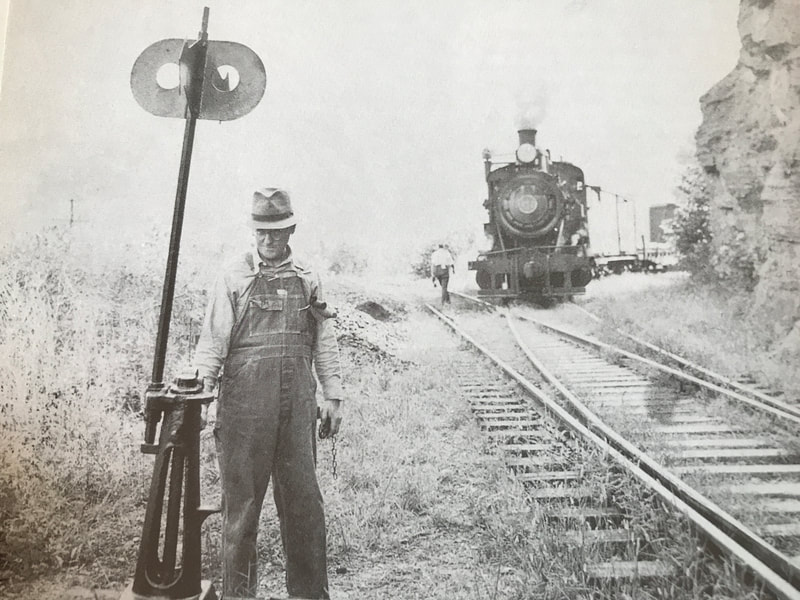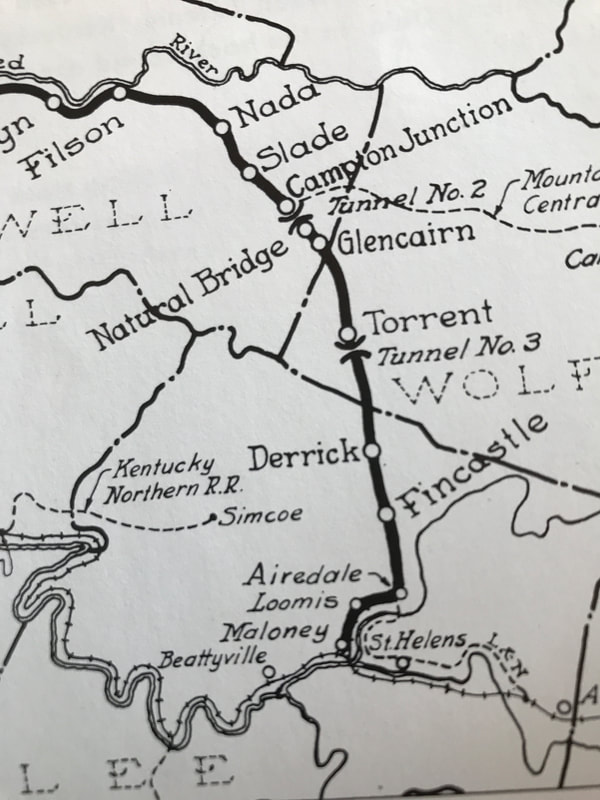|
The Natural Beauty Was Spectacular, Drawing Tourists To What Was Known To Be One Of The Healthiest Places On The Planet
By Bob Smith, 2006 Tourism has long been an economical factor in the Eastern Coal Field section of Kentucky. Even before the turn of the 20th century, promoters were proclaiming this area as one of the healthiest places on the planet to be. Evidence of that philosophy was the resort hotels built for the tourism trade. The L. Park Hotel at Torrent took great advantage of the considerable tourism trade that frequented the L&E Railroad Park at Natural Bridge, three miles from the hotel. Excursion trains brought carloads of tourists from Cincinnati, Dayton, Lexington, and Louisville to enjoy the wild natural beauty and the geological wonders that made up the Natural Bridge Park. Many came and went the same day, but those who stayed overnight had the choice of camping in the park or spending the night at the L. Park Resort Hotel. Park guests frequently chose to travel on to Beattyville where they could spend the night at the luxurious Nina Webb Inn, also billed as a health resort hotel. The L&E did not go to Beattyville but junctioned with the Beattyville and Cumberland Gap Railroad at Maloney. Some park visitors stayed several days to enjoy the scenery and delighted in the side excursions to local communities. The Mountain Central Railway intersected the L&E at Campton Junction (the end of the Natural Bridge tunnel where the sky lift is currently located). From there, the little narrow gage railroad made its way to Campton, the county seat of Wolfe County. The train made it up the steep grade with the assistance of a switchback track system. Still, the incline was dramatic and the scenery was spectacular. At one point in the journey, travelers could look across the cliffs and valley and directly through the Natural Bridge arch itself. Hick Patrick, a former Lee County schoolteacher, once remarked that no roller coaster in the country had a thing on the Mountain Central Railroad when it came to thrills. Mr. Patrick attended the Alvan Drew School, boarding institution located at Pine Ridge, along the train route to Campton, and he was a frequent traveler on the railroad. The late 1800s and early 1900s were a busy time along the L&E (Lexington and Eastern) route which stretched from Winchester to Jackson. The tracks passed through Clay City, Stanton, Natural Bridge, Torrent, Fincastle, St. Helens, Tallega, Athol, and Elkatawa. The photo above shows a L&N Bridge. Kentucky rail mileage reached its maximum by 1930. Over 40 companies operated 5,005 miles of line, scheduling hundreds of passenger trains. Visitors to Campton could find overnight accommodations there or take a short six-mile buggy ride to Hazel Green to find lodging at the Rittenhouse Hotel at the famous Swango Springs Resort. The mineral water from Swango Springs was advertised as "good for most anything that ails you." The late 1800s and early 1900s were a busy time along the L&E (Lexington and Eastern) route which stretched from Winchester to Jackson. The tracks passed through Clay City, Stanton, Natural Bridge (also known as McCormick's), Torrent, Fincastle, St. Helens, Tallega, Athol, and Elkatawa. The rail line was completed to Natural Bridge and Torrent around 1889 and Jackson in the 1890s. The L&E sold out to the L&N (Louisville and Nashville) about 1911 and the tracks were completed to McRoberts in Letcher County to open the coal fields of southeastern Kentucky in 1915. In 1917 the Lee County "Oil Boom" opened the largest oil fields east of the Mississippi River. Lumber was "king" along the L&E, and later the L&N, from around 1890 until the oil boom began. It was the Dana Lumber Company that built the Nada Tunnel and the railroad that opened the Red River Gorge country. The Mountain Central Railroad also began as a lumber carrier, but became a common carrier in 1906. Between Natural Bridge and Torrent the Red River and Beattyville Southern Railroad connected the L&E with the lumber boom town of Ridgewood. Between Torrent and Fincastle the Eastintown rail line junctioned with the L&E on Walker's Creek. It too hauled lumber and logs. The narrow gage line came from the Wolfe County community of Eastintown on Devil's Creek. Numerous tramlines intersected the L&E along its route. The logs were loaded on small carts that ran on narrow tracks and carts were pulled by mules or oxen. The town of Clay City grew up around the Red River Iron Works, but the community was quick to take advantage of the lumber boom and the railroad. Several mills were built to produce lumber and staves. Sawmills, planing mills, and flooring mills sprang up all along the L&E's route. Communities too small for a railroad depot had whistle stops where trains stopped to pick up logs and lumber products that were in great demand in Lexington, Louisville, and cities all over the east. The tourists still came to see Natural Bridge and the scenic waterfalls at Torrent and Fincastle, but investors came as well, especially when the oil fields opened. John D. Rockefeller, Andrew Carnegy, and other wealthy industrialists spent the nights at the L. Park Hotel and Nina Webb Inn. Their boots tread the boardwalks at Fincastle and the muddy streets of Torrent, and they visited oil wells at Fixer, Little Singing, Soreheel Hollow, and Bald Rock. As the oil boom grew, the rich and famous came from New York and Hollywood. Some came to invest, but others came out of curiosity and enjoyed the natural scenery, along with the various aspects of mountain culture, whether it was the gristmill of Tom Johnson on Walkers Creek, the salt peter works under the cliffs that made gunpowder, or the "blind tiger" saloon sitting at the mouth of some hollow. A nitroglycerin manufacturing facility was established by the railroad on Walker's Creek and the first bottled gas in the world was manufactured by the Cumberland Gas Plant at Fincastle in the 1920s and shipped out on L&N rail cars. Fincastle was a popular stop for vacationers and campers coming to Natural Bridge and Torrent. Numerous creeks, waterfalls, caves, rock shelters, and springs were within easy walking distance of the railroad depot and the waters of Walker's Creek were teeming with fish for those who brought along their fishing rods. Nature lovers enjoyed an extra bonus provided by the spectacular array of local wildflower colors. Botanical surveys by the University of Kentucky announced that more species of wildflowers existed within a 25-mile radius of Beattyville than anywhere in the world. Those special days along the L&E were not to last, however. The world was changing too quickly. The lumber business played out about the time WWI came along. The coming of roads and highways would pull traffic away from the railroad. The Depression came along and the L. Park Hotel burned down in 1929. As tourism lagged the L&N built a lodge at Natural Bridge in 1923, but turned the park over to the state in 1927. The opening of the Yellow Rock tunnel by the L&A (Louisville and Atlanta) in 1902 between Beattyville and Irvine opened a simpler, more economical route to transport coal from southeastern Kentucky and the old L&E route was doomed. WWII came and the route was abandoned. In 1942 the tracks were taken up and the steel donated the to war effort. Bob Smith, Editor-Publisher of The Three Forks Tradition newspaper.
0 Comments
Your comment will be posted after it is approved.
Leave a Reply. |
About
Welcome to the blog page of the Three Forks Historical Center in Beattyville, KY. Categories
All
Archives
December 2022
Museum Board Members
Want to get involved? Ask the board members how you can volunteer to help the museum.
Board Members: Linda Smith Josh Smith Jessica Treadway JD Sipple Kenneth Isaacs Suzy Booth Joshua Hagan Ray Shuler Geneva Duncil Frank Kincaid Sherry Lanham Everett Lee Marshall Dedra Brandenburg Board Members in loving memory: Bob Smith 10/30/22 Rhonda Estes 9/20/21 Edna G. Crabtree 2/15/21 |




 RSS Feed
RSS Feed